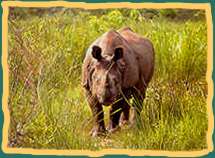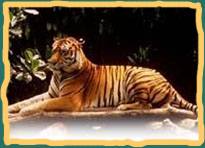|
| |
Chitwaan National Park
For a country known for its beautiful mountains, the Gangetic flat lands of
the Terai that stretches through out the southern part of Nepal provide a
wholly different experience. A visit to Nepal remains incomplete without seeing the beauty
of
the Terai.
And Chitwan is the best place to do so. The Royal Chitwan National
Park,
established in 1973, provides a great wildlife experience with its rich flora
and fauna . The wildlife and the landscape are not as breathtaking as those
found in Africa but still, the experience will stand out.
Chitwan is only 150m
above the sea level. The place gets steamy from March-June, with peak temperatures reaching
43°C in the shade. Short grass
makes Feb-May the best game-viewing season, but the autumn months are gorgeous,
with Himalayan views, and in winter (December-January), Chitwan is pleasantly
warmed compared to Kathmandu. The monsoon season (July-August) is intense, with
pounding rain, swollen rivers, and luxuriant vegetation. While the rain isn't
constant, the humidity is all pervasive.
Places Of Interest
Though one can visit neighboring Tharu
villages in Chitwan, the major interesting
focus of Chitwan is still the exploration of the Chitwan National Park.
Flora and Fauna
The flora and fauna of Chitwan makes it a great place for nature lovers.
Chitwan has over 50
different species of mammals, 400 different species of birds, and
65 different types of butterflies in its hardwood Sal forests,
riverine vegetation, and "elephant grass" savannah. More than 70 different
species of grass grow here.
The most famous wildlife in Chitwan is perhaps the single-horned Asian rhinoceros.
A few decades ago, their number had fallen to less than 100, but recent
count puts them at 400. These animals have thick armor like hide that is
hard to penetrate even with a bullet.

A fully grown animal can be as tall as 180cm. In spite of army protection for
these animals and severe punishment for harming them, rhino poaching is still
a problem as every organ of the animal carries some (probably superstitious)
value. The horn fetches about US$10,000 per kilo and is believed to be an
aphrodisiac. The dung can be a laxative, the urine cures tuberculosis and
asthma. The blood can help cure menstrual problems. The hide keeps away evil
spirits. And so on.
 Chitwan has about 150 Bengal tigers left of the one time 3000 or so.
Though poaching is a serious threat, the real threat for these majestic
animals is the gradual loss of its habitat. A male tiger requires almost
60km space, and a female one requires a third of it. Chitwan is simply not
big enough to handle many tigers. It is rare for one to actually see a tiger,
though looking for one is an interesting part of the trip.
Chitwan has about 150 Bengal tigers left of the one time 3000 or so.
Though poaching is a serious threat, the real threat for these majestic
animals is the gradual loss of its habitat. A male tiger requires almost
60km space, and a female one requires a third of it. Chitwan is simply not
big enough to handle many tigers. It is rare for one to actually see a tiger,
though looking for one is an interesting part of the trip.
Other wild mammals one may see are leopards, various types of deer,
monkeys,
sloth bear, and antelope.
Home
||
Gen
Info ||
Travel
Info ||
Sightseeing
||
Adventure
|| Tour
Packages ||
Helpline ||
Shopping ||
Museums ||
National Parks and
Reserves ||
Festivals ||
Hotels ||
Contact
Us

|